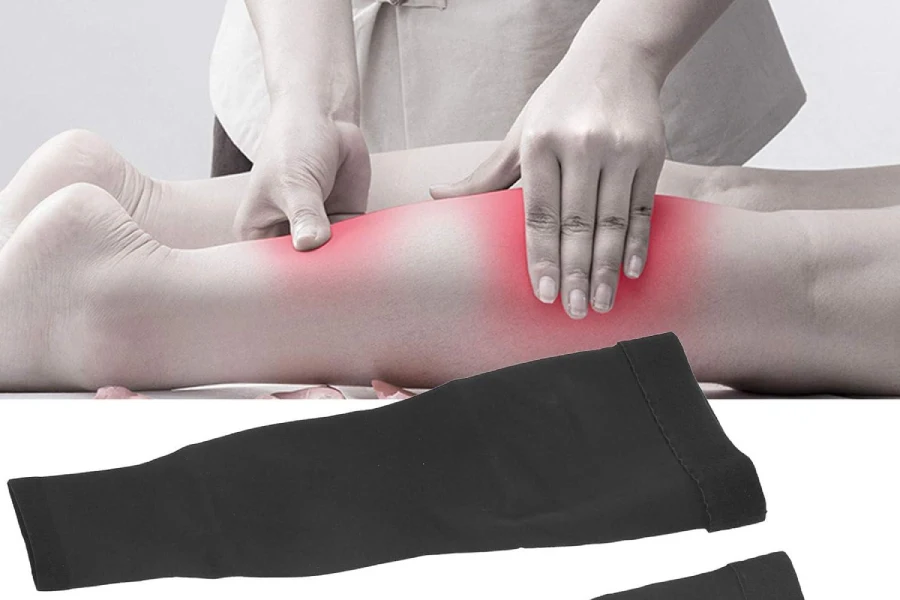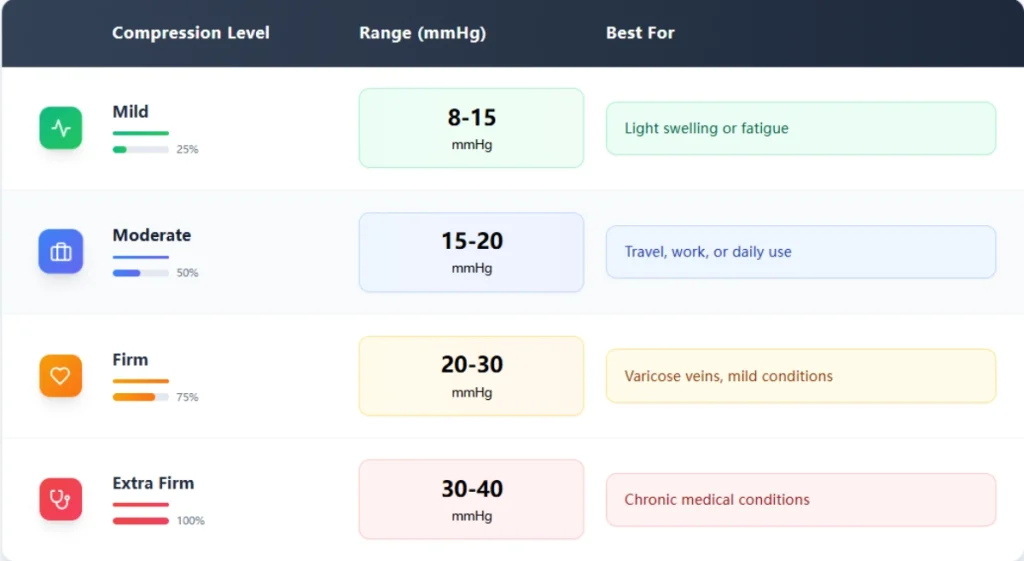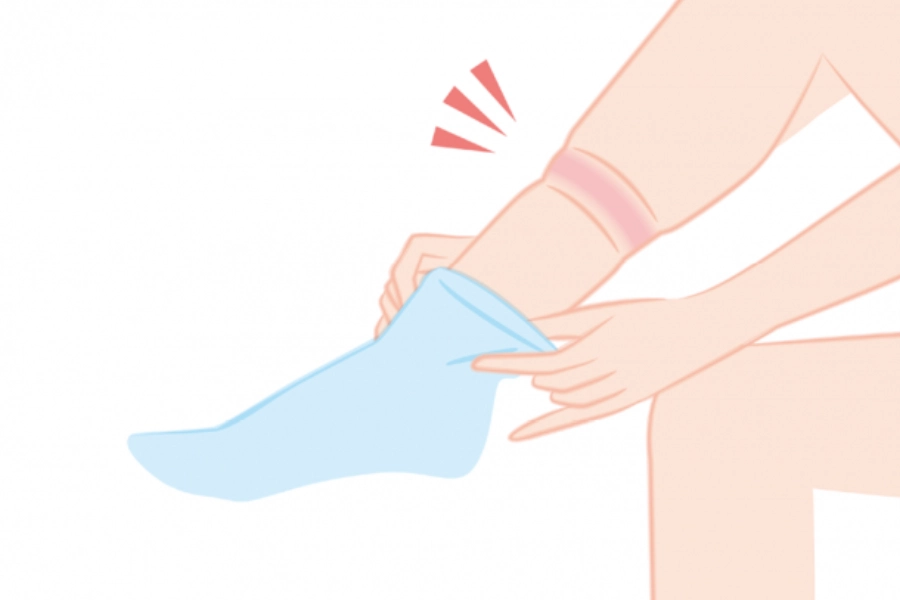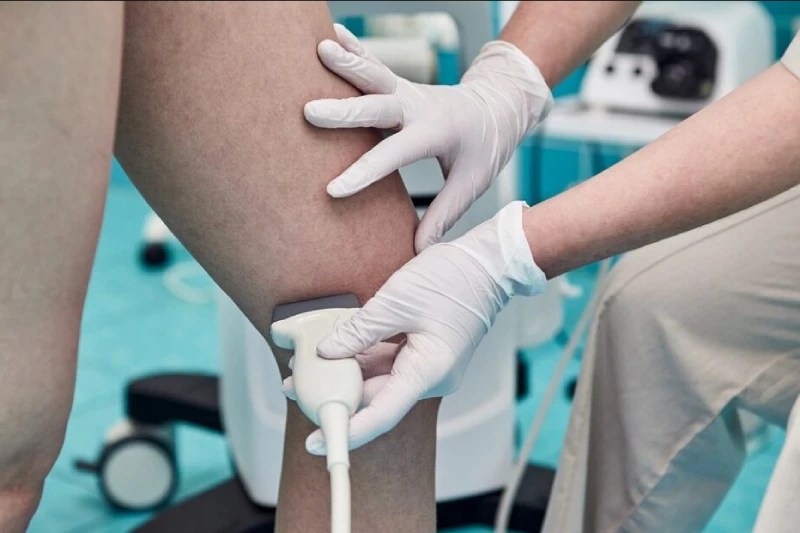Legs aching after wearing compression socks often points to issues like incorrect sizing, the wrong compression level, or wearing them for too long. Sometimes, it can also be due to poor fabric quality or an underlying health condition. Ensuring a proper fit and understanding when to seek expert advice are key to comfortable wear.
Introduction
Compression socks are a popular tool for many people. They help improve blood flow. They can make your legs feel better. Many people wear them for long flights, exercise, or just daily comfort. However, some people feel pain or aching in their legs after wearing them. This can be confusing. After all, these socks are supposed to help, not hurt.

This article will look at why compression socks might cause pain. We will also show you how to avoid this problem. The goal is to help you or your customers understand the reasons behind leg or foot aches after wearing compression socks and get the most benefit from them.
Top 5 Reasons Your Legs Ache After Wearing Compression Socks
Wrong Compression Level
Wearing socks with too much pressure is one of the most common causes of leg pain. Compression is measured in mmHg (millimeters of mercury). Low levels, like 15–20 mmHg, are safe for most daily use. Higher levels, like 30–40 mmHg, are made for medical needs and should only be used with guidance.
Understanding compression levels
There are four main ranges of compression commonly used:

If you use socks that are too strong, they can feel very tight. This can make your legs ache because blood flow is restricted. It can also cause numbness or tingling. If the socks are too weak, you might not feel any relief. Your legs could still feel tired or swollen. It is important to match the sock’s strength to your needs. This makes sure you get the right support without pain. Always check the mmHg rating before you buy. If you’re not sure how to choose the right compression socks, take a look at our detailed guide for helpful advice.
Incorrect Size or Fit
Another reason for discomfort is wearing the wrong size. Socks that are too tight can dig into your legs and restrict blood flow. You might see deep red marks on your skin when you take them off. This leads to discomfort feeling like numbness or tingling. While loose ones can slip or bunch up, causing rubbing or pressure points. They will not help your blood flow as it should. This can still lead to discomfort.
A good fit means the socks feel snug but not painful. They should feel smooth against your skin.
Wearing Them Too Long
Compression socks are meant to be worn for a set amount of time. Most people wear compression socks for about 8 to 12 hours during the day. This is usually enough to get the benefits. For example, if you work a job where you stand or sit a lot, wearing them during your workday can help. If you are traveling on a long flight, you might wear them for the whole journey.
However, wearing them to bed is generally not recommended unless a doctor tells you to.
When you lie down, gravity changes. Your blood flows more easily without the socks. Wearing them at night can sometimes trap fluid. This can make your feet and ankles swell more in the morning. It can also cause skin irritation or make your legs feel restless.
Your skin also needs to breathe. Constant pressure can reduce air flow to your skin. This can lead to dryness, itching, or even small sores if you have sensitive skin. It is good practice to remove your socks before bed. Then, you can elevate your legs slightly. This helps with blood flow and gives your skin a rest.

Always follow the specific instructions that come with your socks. If you are using medical-grade compression socks, your doctor will give you clear advice on how long to wear them.
Poor Fabric Quality
The material of your compression socks matters a lot. Poor quality fabric can make your legs ache. It might not be breathable, heat and moisture become trapped against the skin—creating a breeding ground for bacteria and fungi. Over time, this may result in unpleasant skin issues like irritation, rashes, or even infections.
👉 For a full breakdown of which materials are best for comfort and durability, read our guide on compression sock fabrics and yarn types.
Cheap materials might also lose their stretch quickly. This means they will not give the right amount of compression. They might become too loose in some areas and still too tight in others. This uneven pressure can cause pain and defeat the purpose of wearing compression socks.
Underlying Health Conditions
Sometimes, the problem isn’t the sock—it’s what’s going on inside your body. If your veins or nerves are already affected by certain conditions, compression socks might make the discomfort worse.
Conditions like venous insufficiency, peripheral artery disease, or nerve disorders can all influence how your legs react to pressure.
When pain is a medical warning
Here are some signs your pain could be related to a health issue:
| Symptom | Possible Cause |
|---|---|
| Tingling or numbness | Nerve compression or poor circulation |
| Redness and swelling | Inflammation or poor lymph flow |
| Sharp pain in one leg | Possible deep vein issue |
How to Avoid Discomfort from Compression Socks
Based on the five common causes of leg pain mentioned earlier, we have compiled detailed and practical solutions. Whether the issue stems from improper sizing, incorrect compression level, poor materials, or wearing habits, each problem can be effectively addressed with the right approach. In the following sections, we will analyze these causes one by one and offer specific recommendations.
For people who sell or customize socks, these tips are just as important. A few simple changes in material, fit, or design can make the product more reliable and easier to wear.
Start with short wearing times
If it’s your first time, don’t wear compression socks all day. Start with 1 to 3 hours. Slowly increase the time over several days. This gives your body time to adjust.
You should also pay attention to how your legs feel during and after wearing them. If you notice pressure lines or soreness, remove them and check the size and compression level.
Once you’re used to wearing them, daily use between 6 and 10 hours is often safe. But you should still take breaks. Remove the socks when resting or lying down, unless advised by a doctor.
How to measure your legs correctly
The most common cause of compression sock pain is wearing the wrong size. Even a 1 cm mistake in measurement can lead to discomfort. Here’s how to do it properly:
Watch our step-by-step video below to see exactly how to measure your legs for the best compression sock fit.
What You’ll Need:
- Flexible tape measure
- Chair or flat surface to sit on
- Pen and notepad
When to Measure:
To get a proper fit, you need to measure your legs when they’re not swollen—ideally first thing in the morning. Use a soft tape and measure:
- Ankle circumference (just above the ankle bone)
- Calf circumference (the widest part of your lower leg)
- Leg length (from floor to just below your knee)
| Area | Measurement Tip |
|---|---|
| Ankle | Wrap snugly around the narrowest part |
| Calf | Measure the widest point |
| Leg Height | From heel to bend of the knee |
Compare your numbers with the size chart provided by the product. If your sizes are between two categories, choose the larger one to reduce pressure. An incorrect fit is the fastest way to turn a helpful product into a painful one.
Choose breathable, soft materials
Socks made with high-quality yarns will stretch better and feel more gentle on the skin. Materials also affect moisture control and heat.
Here’s a list of recommended blends for comfort and performance:
| Material Type | Properties |
|---|---|
| Nylon + Spandex | Strong compression, durable stretch |
| Cotton + Spandex | Breathable and soft for all-day use |
| Polyester + Coolmax | Moisture-wicking, good for active use |
| Bamboo + Nylon | Soft texture, good airflow |
Avoid socks that feel stiff or synthetic. These may cause friction or trap sweat. For brands or B2B buyers, consider fabrics that are OEKO-TEX certified or use seamless technology to improve wearability.
Use open-toe socks if needed
Some people experience toe discomfort from closed designs. Open-toe socks allow more air and reduce pressure at the foot tip. They’re also easier to wear with sandals or during warmer months.
Use open-toe options for users with bunions, wide feet, or diabetes-related issues. This will reduce pain and help customers wear them longer.
For private labels or wholesalers: Pick better specs
If you’re sourcing or customizing compression socks, better construction means fewer returns. Here are some quick tips:
- Use soft double-layer cuffs to reduce red marks
- Offer 2–3 compression levels for different users
- Include a sizing chart with each product
- Use cotton-spandex blends for daily wear models
- Offer seasonal fabric types (cooler for summer, thicker for winter)
Custom socks that balance function with comfort help build trust with your buyers. If your product causes pain, users are unlikely to wear it again—or reorder it.
Expert Advice and Medical Guidance
Not all leg pain from compression socks comes from poor fit or fabric. Sometimes, it signals a medical issue. If symptoms are severe or persistent, professional help is essential. Medical experts can check your circulation and guide you to the right sock type and compression level.
What doctors and specialists recommend
Health professionals agree that compression socks are helpful when used correctly. If they cause pain, numbness, or swelling, something is likely wrong.

Vascular Surgeons
These doctors treat blood flow disorders. According to the Society for Vascular Surgery, compression therapy is often helpful for vein problems. But wearing too strong a level or the wrong size may block return flow rather than support it.
“The most common issue is using socks that are too strong or not measured right,” says Dr. Tan, a vascular surgeon. “This can block return flow instead of helping it.”
Physical Therapists
Therapists often recommend light-to-moderate compression to ease swelling after surgery or standing. But as Cleveland Clinic notes, compression should be used during waking hours, not overnight unless a doctor advises otherwise.
They suggest breaking in new socks gradually and monitoring pressure-sensitive areas.
Podiatrists
Foot doctors focus on fit and material. According to the American Podiatric Medical Association (APMA), socks with poor toe space or stiff seams can cause foot issues. If you have bunions, hammer toes, or neuropathy, choose open-toe or soft-cuff styles.
They also advise inspecting skin daily. If you see redness, bumps, or sores, stop wearing the socks and consult a podiatrist.
When to seek professional help
Here are signs that may require medical attention:
| Symptom | What It Might Mean |
|---|---|
| Continuous pain after removal | Vein blockage or nerve irritation |
| Skin turns red, hot, or blotchy | Inflammation or allergic reaction |
| Numbness, burning, or tingling | Nerve compression or improper sizing |
| Swelling that doesn’t go away | Possible venous insufficiency |
| Pain in only one leg | Possible deep vein clot (DVT) |
| Chest pain or shortness of breath | Emergency: potential blood clot |
According to Johns Hopkins Medicine, DVT symptoms can start in the legs and lead to more dangerous conditions like pulmonary embolism if not treated quickly.
What doctors can do to help
Medical professionals may recommend the following after a basic checkup or ultrasound scan:
- Custom sock recommendations
- Prescription-grade compression ranges (e.g., 20–30 mmHg)
- Advice on how long to wear them daily
- Monitoring for improvement or complications
These actions help ensure compression therapy works safely. When used with guidance, compression socks can be part of a larger plan to manage chronic vein or circulation issues.
For more, you can also refer to the National Institutes of Health (NIH) summary on compression therapy for venous conditions.
Conclusion
Compression socks can be a simple way to improve leg health and reduce discomfort. But the key lies in how you choose and use them. A proper fit, the right compression level, and a gradual adjustment period all matter.
If your legs hurt after wearing them, check the basics first. But if pain continues or warning signs appear, don’t delay—seek medical advice to rule out deeper issues.
At Max Hosiery, we specialize in manufacturing high-quality compression socks tailored to your market. Whether you’re a brand, retailer, or e-commerce operator, we offer private label solutions designed for comfort, function, and consistency. Contact us to customize compression socks that meet your customers’ needs.
FAQ
Can compression socks cause achy legs?
Yes, they can—especially if the compression level is too high or the size is incorrect. Tight socks may restrict blood flow, causing aching, numbness, or pressure. If the fabric is stiff or the socks are worn too long, discomfort is more likely. Always check fit, material, and wear time.
How do you tell if compression socks are cutting off circulation?
Warning signs include numbness, tingling, cold feet, or toes turning pale or bluish. Deep red indentations around the top band can also suggest the socks are too tight. Properly fitted compression socks should feel snug but never painful or restrictive.
Where does the fluid go when you wear compression socks?
Compression socks gently push fluid upward through your veins and lymphatic system. This helps reduce swelling by moving excess fluid from the lower legs back toward the upper body, where it’s processed and removed. It’s especially helpful for people with mild edema or standing jobs.
Why do my legs hurt after removing compression stockings?
Leg pain after removal often means the socks were too tight, worn for too long, or not the right type for your condition. It might also indicate underlying issues like vein disease or poor circulation. If the pain doesn’t go away or gets worse, consult a medical professional.
Can I wear compression socks to bed?
Unless prescribed by a doctor, wearing compression socks while sleeping isn’t recommended. Your blood flows more freely when lying down, so extra pressure isn’t needed. Overnight use can cause skin irritation or fluid buildup in some cases. Always follow usage instructions provided.
